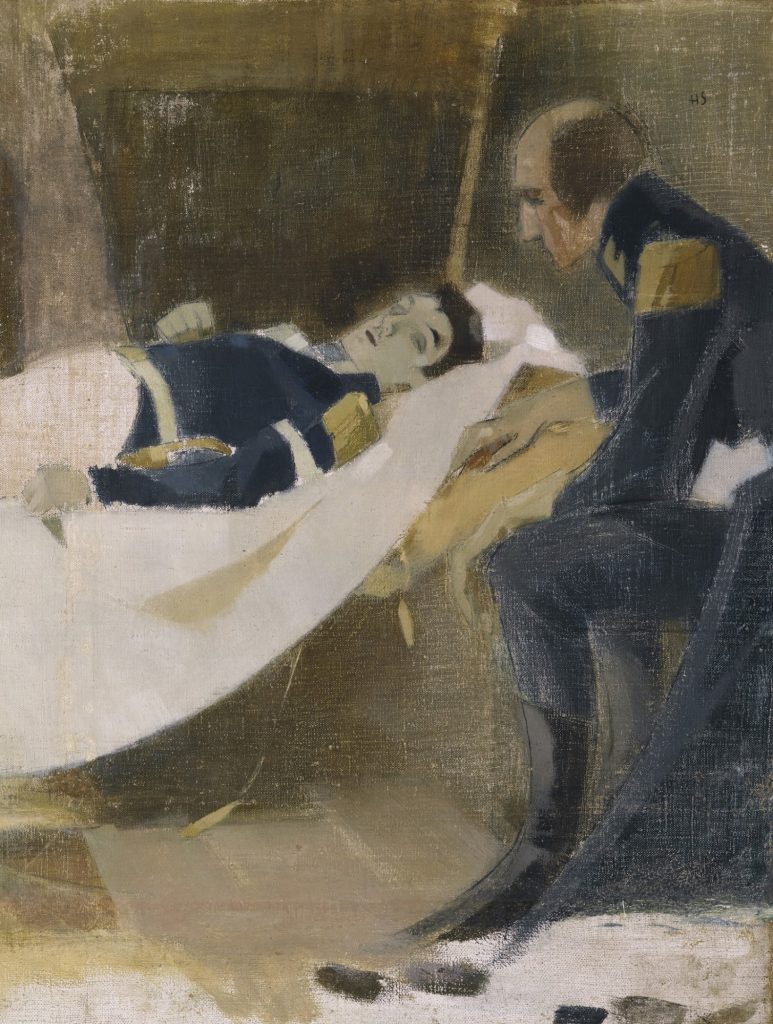A new interpretation of a Runebergian motif
Helene Schjerfbeck’s work Death of Wilhelm von Schwerin is a history painting based on J. L. Runeberg’s poem by the same name. Schjerfbeck has made altogether three interpretations of the subject.
The poem was published in 1860 in the second volume of The Tales of Ensign Stahl. Runeberg’s poetry book describes the events of the Finnish War waged 1808–1809, and at its publication it was a significant literary presentation of Finnish history. The story of a 15-year-old youth, who received deadly wounds at the battle of Oravainen, was one of the central episodes of the book.
Along with poetry, also art of painting was looking back at the past. The most appreciated type of visual arts was history painting that drew its motifs from the great turning points of history but also literary subject matters. Wilhelm von Schwerin’s character fits both categories.
Helene Schjerfbeck painted altogether three paintings with this motif. The two first of them represent the genre of history painting. Schjerfbeck was 17 years old while painting her first, more sketch-like version in 1879. She completed the second version in 1886. At that time Schjerfbeck, now in her twenties, had already studied in Paris for a while, and had had time to adopt naturalistic expression. Naturalism that strived for objectivity and truthfulness was the central way of expression of history painting, and in her version from 1886 Schjerfbeck has depicted mourners that have gathered around the young deceased restraint and as a kind of an affirmation.
Schjerfbeck painted her last interpretation of this motif in 1927. At that time over forty years had passed between the second and the third version. During that time Helene Schjerfbeck had resided and painted in France and in Britain, travelled in Italy, Austria and Russia, among others. In Finland she worked as a drawing teacher at the Art Society’s drawing school in Helsinki. After that she relocated in 1902 to Hyvinkää and stayed there for the next 15 years. She did not travel anywhere, consciously keeping her distance to the artist circles of Helsinki. As a result, she developed the personal painting style of her own.
Artist’s important contact person outside Hyvinkää was art dealer Gösta Stenman. On his initiation Schjerfbeck worked on new interpretations of some of her works from the 1880s. They included The Convalescence (1888). To this entity of works belongs also the third in-row Death of Wilhelm von Schwerin pertaining to the collections of Gösta Serlachius Fine Arts Foundation.
The work manifests the development in Schjerfbecks’s art during her Hyvinkää years. The composition is tighter than earlier and restricted to the upper torso of the deceased and the officer sitting closest to him. The artist has withdrawn herself from the naturalistic expression of the version painted in 1886. Instead she has superseded it with a simplified work consisting of flat colour fields and sophisticated transitions between them. The points with intense luminosity are referred to only with a couple of seemingly coincidental but in reality highly deliberated light patches of colour.
The concept of a young war hero who died for his fatherland was, as a motif, profoundly Runebergian. However, in the version from 1927, history and the literary reference of the work have receded in to background. Instead of Wilhelm von Schwerin who died young, the main character in Schjerfbeck’s painting is the officer sitting next to him. He seems to have quiet down to ponder the fragility of life and insanity of war.
Suvi-Mari Eteläinen
Curator


